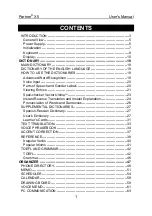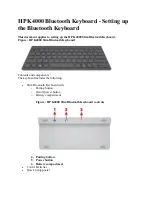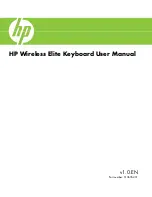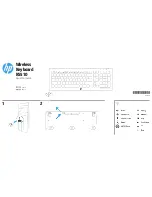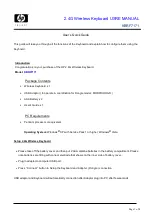
21
RE4: Amplitude Decay Track
Displayed as:
AmpDecTk
Initial value:
0
Range of adjustment:
-64 to +63
This parameter works in exactly the same way as
Attack Track
, except that it is the Decay
time of a note that becomes dependent on its position on the keyboard.
RE5: Amplitude Sustain Rate
Displayed as:
AmpSusRt
Initial value:
Flat
Range of adjustment:
-64 to Flat to +63
With this parameter set to Flat, the volume during the Sustain phase of the envelope re-
mains constant. Additional variations to a note’s character can be obtained by causing the
note to become louder or quieter while the key is held. A positive value of
Sustain Rate
will cause the volume to increase during the Sustain phase, and it will continue to do so
until maximum level is reached. The parameter controls the rate at which the note increases
volume, and the higher the value, the faster the rate of increase. Any Release time set will
act as normal when the key is released, whether or not the maximum volume has been
reached. If a negative value is set, the volume during the Sustain phase drops, and if the
key is not released, the note will eventually become inaudible.
Lower values (positive or negative) of Amplitude Sustain Rate are generally
more useful.
RE6: Amplitude Sustain Time
Displayed as:
AmpSusTm
Initial value:
127
Range of adjustment:
0 to 126, KeyOff
This parameter sets the duration of the Sustain phase. With a value of KeyOff, the note will
remain audible continuously until the key is released (unless a negative value of
Sustain
Rate
has been applied to reduce its volume). Any other value of
Sustain Time
will cut
the note off automatically after a pre-determined time if the key is still held down.
Release
Time
still applies if the key is released sooner. A value of 126 sets the Sustain time to ap-
prox. 10 seconds, while values around 60 set it to about 1 second.
RE7: Amplitude Level Track
Displayed as:
AmpLvlTk
Initial value:
0
Range of adjustment:
-64 to +63
This parameter works in a similar way to the other “tracking” parameters
Attack Track
and
Decay Track
(
RE3
&
RE4
), but it is the volume of the note which is changed, according to
the interval between it and the
Track Note
set by
RE8
. With a positive value, notes higher
than the Track Note get progressively louder the further from the Track Note they are, and
vice-versa. With a negative value, notes higher than the Track Note get progressively qui-
eter the further from the Track Note they are, and again, vice-versa. Note that this volume
modiication is applied to all phases of the amplitude envelope equally; it is the overall
volume of the note which changes with
Level Track
. The effect should be used sparingly;
low values have a better effect.
Note that although Amplitude Level Track appears to operate in a very similar
manner to Amplitude Attack Track and Amplitude Decay Track, only Level Track
uses a user-deinable note as the reference (
set by RE8
), above which notes
get louder and below which get softer. The Attack and Decay Track parameters (
RE3
and
RE4
) have a ixed reference note at C 3.
Common Envelope Parameter
This parameter is available on Page 2 of the menu for every Envelope.
RE8: Level Track Reference Note
Displayed as:
LvlTkNte
Initial value:
C 3
Range of adjustment:
C -2 to G 8
This sets the reference note used for
Amplitude Level Track
. When active, this parameter
increases the volume for notes above the chosen Track Note, and reduces it for notes
below it. C 3, the default value, is Middle C on the keyboard; this is the C one octave above
the lowest note on the keyboard (also C), providing no
OCTAVE
buttons [32] are selected.
Envelope 2 (Filter) parameters (Page 1)
The parameters available for adjustment with Envelope generator 2 closely match those for
Envelope generator 1. Whereas Envelope 1 is concerned with modiications to the sound’s
amplitude envelope, Envelope 2 gives you “dynamic” iltering, by establishing a relationship
between the ilter section and ADSR Filter Envelope 2, resulting in the ilter frequency be-
ing varied by the shape of the envelope.
In order to hear the effect of any of the Filter Envelope parameters, you will irst
need to go to the Filter Menus and set up some iltering. Then set
RE5
on Filter
Menu Page 1 (
F1Env2
or
F2Env2
) to an initial value of approx. +30 and ensure
that the ilter is not fully open – i.e., set
F1Freq
to mid-range.
RE1: Filter Attack Time
Displayed as:
FltAtt
Initial value:
2
Range of adjustment:
0 to 127
This parameter sets how the ilter section acts during the note’s Attack phase. The higher
the value, the longer it takes for the ilter to react during this phase.
To evaluate the action of the Filter Envelope parameters for each of the ADSR
phases (
RE1
to
RE4
), it may be helpful not to set all three to zero.
RE2: Filter Decay Time
Displayed as:
FltDec
Initial value:
75
Range of adjustment:
0 to 127
This parameter sets how the ilter section acts during the note’s Decay phase. Again, the
higher the parameter value, the longer the period for which iltering is applied .
RE3: Filter Sustain Level
Displayed as:
FltSus
Initial value:
35
Range of adjustment:
0 to 127
The frequency of the ilter (cut-off or centre, depending on ilter type) “settles” at a value
set by the
Filter Sustain Level
. Thus, once the Attack and Decay stages of the envelope
are completed, the harmonic content that will be most evident in the sound will be deter-
mined by this parameter. Remember that if the ilter frequency parameter (as set in the Filter
Menu) is set at a too low or too high a value, the envelope’s effect will be limited.
RE4: Filter Release Time
Displayed as:
FltRel
Initial value:
45
Range of adjustment:
0 to 127
As
Filter Release
is increased in value, the note undergoes increasingly more ilter action
once the key is released.
Note that the
Amplitude Release
time (in Envelope 1’s parameters) must be set
suficiently high to produce an audible “fade-out” before the effect of iltering on
the “tail” of the note is evident.
ATTACK
DECAY
RELEASE
SUSTAIN
SUSTAIN
RATE
TIME
KEY "ON"
KEY "OFF"
VOLUME
ATTACK
DECAY
RELEASE
SUSTAIN
SUSTAIN TIME
TIME
KEY "ON"
KEY "OFF"
VOLUME
OSCILLATORS
O1Semi
O1Cents
O1VSync
O1Wave
O1PW/Idx
O1Hard
O1Dense
O1DnsDtn
0
0
0
Sawtooth
0
127
0
0
O1PtchWh
O1WTInt
FixNote
ModVib
MVibRate
OscDrift
OscPhase
NoiseTyp
+12
127
Off
0
65
0
0deg
White
O2Semi
O2Cents
O2VSync
O2Wave
O2PW/Idx
O2Hard
O2Dense
O2DnsDtn
0
0
0
Sawtooth
0
127
0
0
O2PtchWh
O2WTInt
FixNote
ModVib
MVibRate
OscDrift
OscPhase
NoiseTyp
+12
127
Off
0
65
0
0deg
White
O3Semi
O3Cents
O3VSync
O3Wave
O3PW/Idx
O3Hard
O3Dense
O3DnsDtn
0
0
0
Sawtooth
0
127
0
0
O3PtchWh
O3WTInt
FixNote
ModVib
MVibRate
OscDrift
OscPhase
NoiseTyp
+12
127
Off
0
65
0
0deg
White
FILTERS
F1Freq
F1Res
F1Env2
F1Track
F1Type
F1DAmnt
F1DType
F1QNorm
127
0
0
127
LP24
0
Diode
64
FBalance
FRouting
FreqLink
ResLink
-64
Parallel
Off
Off
F2Freq
F2Res
F2Env2
F2Track
F2Type
F2DAmnt
F2DType
F2QNorm
127
0
0
127
LP24
0
Diode
64
FBalance
FRouting
FreqLink
ResLink
-64
Parallel
Off
Off
ENVELOPES
AmpAtt
AmpDec
AmpSus
AmpRel
AmpVeloc
AmpRept
AmpTTrig
AmpMTrig
2
90
127
40
0
0
OFF
Re-Trig
AmpAtSlp
AmpDcSlp
AmpAttTk
AmpDecTk
AmpSusRt
AmpSusTm
AmpLvlTk
LvlTkNte
0
127
0
0
0
127
0
C 3
FltAtt
FltDec
FltSus
FltRel
FltVeloc
FltRept
FltTTrig
FltMTrig
2
75
35
45
0
0
OFF
Re-Trig
FltAtSlp
FltDcSlp
FltAttTk
FltDecTk
FltSusRt
FltSusTm
FltLvlTk
LvlTkNte
0
127
0
0
0
127
0
C 3
E3-E6
E3Att
E3Dec
E3Sus
E3Rel
E3Delay
E3Repeat
E3TTrig
E3MTrig
10
70
64
40
0
0
OFF
Re-Trig
E3AtSlp
E3DcSlp
E3AttTk
E3DecTk
E3SusRat
E3SusTim
E3LvlTk
LvlTkNte
0
127
0
0
0
127
0
C 3

































